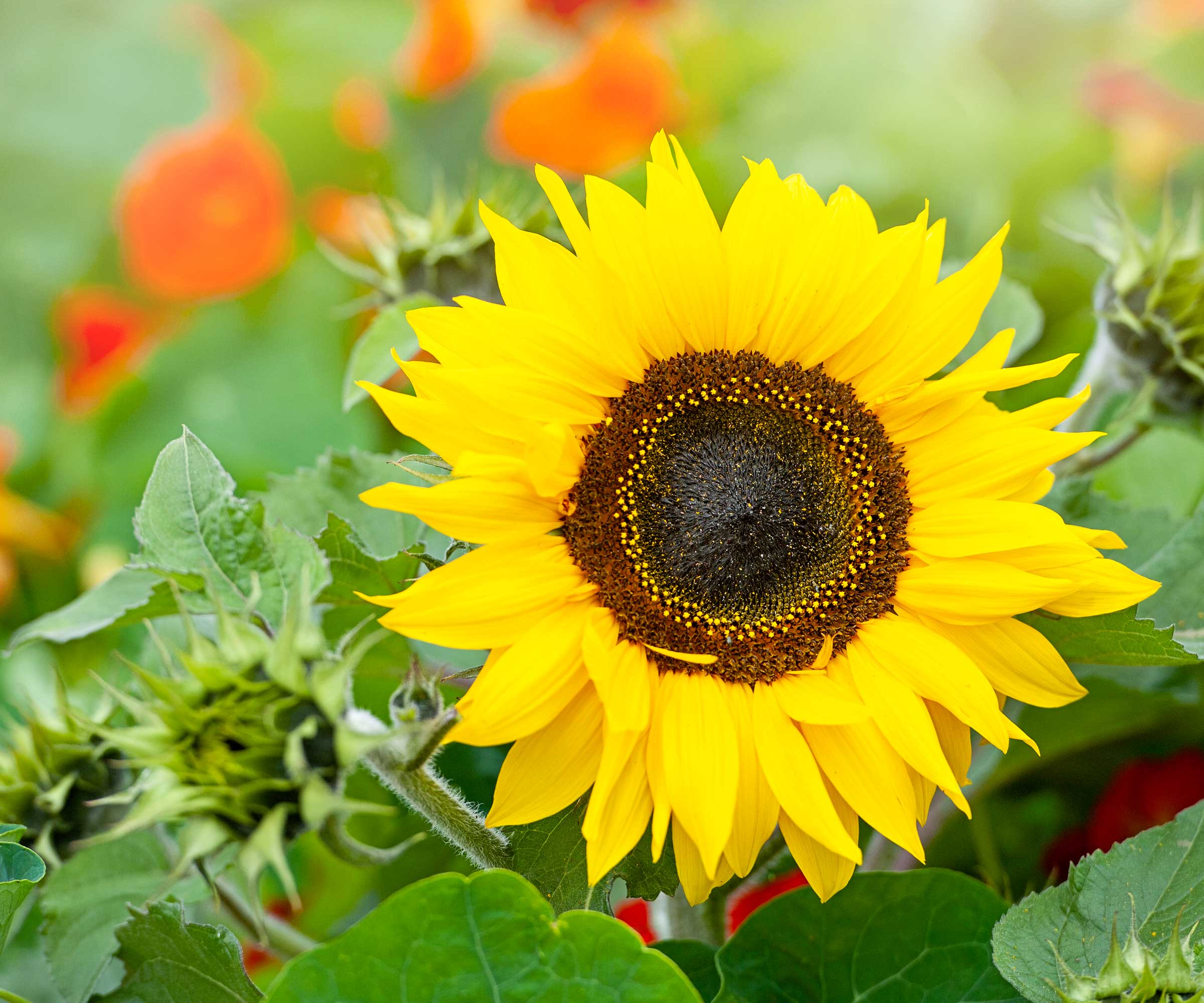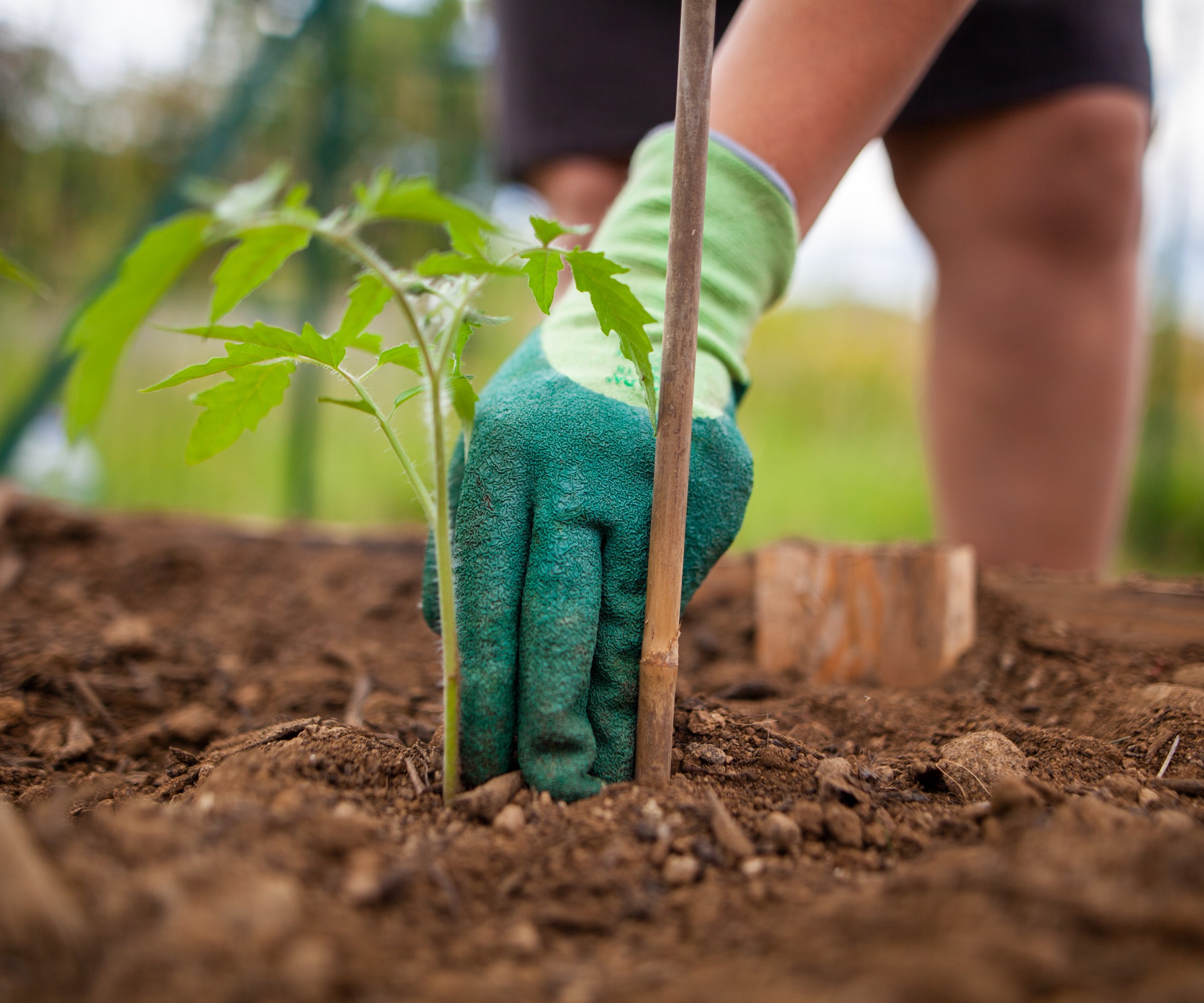7 beautiful flowering plants to stake – expert tips to keep blooms and vegetables thriving all summer long
A supported garden is a beautiful one


A thriving and colorful garden is all the more healthy and beautiful when given the right support.
Much like pruning and deadheading plants can encourage new growth, giving stems and the fruit that a plant bears the support that it needs will increase the chances of a crop to be proud of.
If you are wondering which flowering plants need staking at this time of year, some may surprise you.

7 flowering plants to stake
From reducing the need for pest control to guiding them at every stage of their growth, here are flowering plants to stake in your garden:
1. Delphiniums

The tall stature and bold brights of delphinium plants are a sight to covet throughout the summer. In borders or containers, these cottage garden plants dazzle. To ensure healthy growth, they need support and protection from the elements:
'These are tall, with beautiful flower spikes, making them very vulnerable to wind and heavy rain,' says Samuel Davis, horticulturist and the CEO of London Gardeners.
Their hollow, brittle stems are susceptible to breaking unless staked. 'Take strong stakes and place them close to the plant, gently securing the stems but firmly,' adds Samuel.
Design expertise in your inbox – from inspiring decorating ideas and beautiful celebrity homes to practical gardening advice and shopping round-ups.
Giving this flower the right support during the summer months is part and parcel of caring for delphinium plants, but make sure you do so in anticipation of their growth.
'These tall beauties can easily topple over as they reach their peak height if not properly supported,' says Victoria Cummins, senior editor at PlantWhisperer. 'I recommend staking delphinium plants early in the season before the stems start to bend.'
And if you are curious to know about the aftercare for this bloom, H&G garden expert Thomas Rutter shares exactly what to do with delphiniums when they finish flowering.

Samuel Davis, a horticulturist and the CEO of London Gardeners, brings a green thumb and strategic vision to the helm. Under his leadership, London Gardeners has blossomed into the go-to destination for premier gardening services in the city, fostering beautiful landscapes while nurturing a commitment to environmental stewardship.
2. Sunflowers

The cheery disposition of sunflowers will lift the mood of every backyard space. However, the wonderfully striking head full of sunflower seeds – that are a delight to harvest for following years – can be cumbersome to its stem.
'As sunflowers are very tall and their flower head gets very heavy, staking may be necessary,' says Samuel.
How much support a sunflower needs might depend on the variety: 'One good stake per plant is adequate. The stem should be fastened loosely for both growth and movement.' Be sure to check how tall yours might grow so that you are prepared.
'Even mighty sunflowers, especially the skyscraping varieties, need a helping hand (or stake) in pots to withstand summer gusts,' adds Victoria.

Victoria Cummins of the PlantWhisperer website is a gardening expert, who specializes in permaculture. Her work focuses on building soil quality, cultivating fruit trees, and wild harvesting. Collaborating with homeowners, landowners, farmers, gardeners, and communities, she dedicates her expertise to healing landscapes and enhancing food production to create resilient, sustainable environments.
3. Peonies

There is nothing quite like observing the intricate petal structure of peonies as they unveil over long summer days. Cages are often used for this elegant flower as peonies need support to keep them standing tall.
'Peonies and lilies grown in pots also need extra support to keep their glorious blooms upright and on display,' continues Victoria. When growing peonies in beds or containers, it is crucial to lend a hand to ward off pests and problems too, allowing them to thrive at full height, even in harsh winds and rain.
4. Asters

There are also more unlikely flowering plants to stake. As touched on, some Lily varieties will benefit from staking (though Canna lilies are happily grown without). Some Aster varieties for example, (particularly tall plants), can also do better with some support, when in borders or summer containers.
Asters make beautiful late-summer bloomers for those who want brighter pops of color to brighten up their outdoor space through until the change in season when tonal fall planting will take precedence.
'For potted asters and Michaelmas daisies, I like to use natural-looking supports like twiggy branches to blend in with the plant while keeping them standing tall through the fall,' adds Victoria. For this, consider something from the garden or small bamboo canes that can be found on Amazon.
5. Dahlias

Dahlias are welcome additions to all outdoor spaces and their colorful blooms will fill a backyard or small patio with joy since dahlias can be grown in the ground but also in pots.
There are currently 42 'recognized' species of dahlias' according to the American Dahlia Society, with several subspecies, and each will benefit from wooden stakes to stop them from collapsing. Take the orange-toned-decorative Dahlia 'Bettina Verbeek' we can see in flower above as an example. Simple garden stakes such as these bamboo flower support sticks on Amazon will help them grow into their beauty with all they need.
'They require strong support because of their big and heavy blooms,' adds Samuel. 'A good support is the use of a bamboo stake placed at the time of planting so it doesn't cause injury to roots.
'As the plant grows, the main stem should be tied continuously at regular intervals to the stake.'
6. Tomatoes

A bamboo cane can be put in place when planting the young tomato
Though the delicate yellow flowers you will see when you start growing tomatoes do not seem cumbersome to this summer-growing plant, the fruit they bear is heavy – all for a more delicious crop – and the long thin stems need an extra hand to keep them off the ground in a kitchen garden for better growth.
'Tomatoes are among the most common plants that require staking,' says horticulturalist Nisha Maxwell. 'As they grow heavier with fruit, their branches can easily break or droop to the ground which causes disease and offers first harvest rights to the ground-dwelling critters.' As well as keeping slugs a little further away, stakes will help air circulate the vines.
There are different methods of how to stake a tomato plant that gardeners use. As well as stakes you can use cages like this K-Brands Tomato Cage available on Amazon for more height. The stakes or cages must provide the support your plant needs throughout its growth until harvest.
'Drive stakes about a foot deep into the ground and tie the main stem loosely to the stake with twine or plant ties, ensuring you don't damage the stem,' says Nisha.
To attach this flowering plant to the stake or cage, we propose clear tomato clips available at Amazon as they are less restrictive, with wide applications, and will enhance the aesthetic appeal of your vegetable garden too.
If you would like classic wooden stakes, we found these tall 1.2-meter-long contenders on Amazon.

Nisha Maxwell is a landscape designer, desert farmer, and horticulturalist based in Joshua Tree. Nisha holds a Permaculture Design Certificate, certified by Permaculture Institute of North America through Oregon State University with Andrew Millison, and is a Certified Producer for vegetables and microgreens in Los Angeles and San Bernardino County.
7. Cucumbers

Cucumbers, like tomatoes, are a flowering plant that you will often find pitched on vegetable trellis since a good harvest will be a heavy one. If you have a smaller growing space and have planted cucumbers in containers, they can be staked individually with bamboo. '
By driving a stake into the ground next to each plant and tying the vines as they grow, you can guide them upwards,' adds Nisha. 'This vertical growth keeps the cucumbers off the soil, reducing the risk of rot and making them easier to harvest. Staking also helps in managing the plant's sprawling nature, keeping the garden more organized. Just make sure to use strong loose ties.'
Healthy plants will naturally be all the more tasty and you might be in a position to save cucumber seeds until next year too.
'With proper staking, your potted flowering plants will reach their full potential all summer long,' continues Victoria. 'The key is getting the timing right and choosing stakes that provide stability without distracting from the plant's beauty.'
Remember that when planting flowers and plants that need staking, maintenance is important too. 'The most important thing about staking is that you cannot just do it once and never revisit the project,' shares Nisha. Especially for tomatoes and heavier flowers, ensure ties are loose but in the right places to help them thrive. Whether you are creating a modern cottage garden or prairie gardening on a small balcony, keep a watchful eye on your plants for a fruitful season.

Camille is the former deputy editor of Real Homes where she covered a broad range of topics, including house tours, small space design, and gardens. She studied English language and Italian at the University of Manchester and during a year abroad studying linguistics and history of art in Bologna, Italy she started documenting her adventures and observations in a blog. Camille is always creating and spends her downtime painting, taking photos, traveling, and writing short stories.